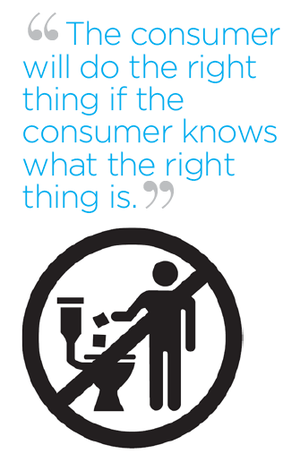As wastewater treatment plants across the country from Minnesota to New York City struggle with debris clogging their systems, municipalities are pointing the finger at wipes makers—specifically those labeled flushable. But the nonwoven fabrics industry says it’s working to educate the public about the proper disposal of all wipes.
But David Rousse, president of INDA, the Association of the Nonwoven Fabrics Industry, says the association is working to analyze the debris at wastewater plants to determine the real problem, which he says is not flushable wipes, but rather, wipes not intended to be flushed.
Non-flushable wipes, he says, make up 93 percent of wipes products, which include items such as baby wipes, hard-surface wipes like Clorox or Lysol wipes, and others not made to flush.
“We can flush golf balls and fertilizer and antibiotic,” says Rousse. “None of that is supposed to be flushed, but it can pass through a toilet.”
In February, Brooklyn resident, Dr. Joseph Kurtz, filed a federal class-action lawsuit, seeking at least $5 million, against wipes maker Kimberly-Clark and Costco Wholesale corporations. The suit, filed in the Eastern District of New York, represents 100 people and claims that wipes are causing clogged pipes and sewers, flooding, and problems with septic tanks nationwide.
“The defendants should have known that their representations regarding flushable wipes were false and misleading,” the complaint states.
The problem doesn’t end at the sewers. The New York City Department of Environment also has fingered the nonwovens industry, saying the damaging wipes are falsely labeled as flushable.
 In March, New York City DEP Commissioner Emily Lloyd testified before the city’s Council Committee on Environmental Protection, touting the introduction of bill 666, which would prohibit the sale of nonwovens marked as “flushable.” Lloyd said the city estimates wipes have cost approximately $3 million annually in cleaning of fouled screens, repair of seized pumps, as well as extra landfill costs.
In March, New York City DEP Commissioner Emily Lloyd testified before the city’s Council Committee on Environmental Protection, touting the introduction of bill 666, which would prohibit the sale of nonwovens marked as “flushable.” Lloyd said the city estimates wipes have cost approximately $3 million annually in cleaning of fouled screens, repair of seized pumps, as well as extra landfill costs.
According to the DEP, in January 2007, the screens at DEP’s 14 plants captured more than 4,000 cubic yards of debris. In January 2013, that number increased to more than 10,000 cubic yards, and last year, more than 40,000 tons of improperly disposed wipes were netted.
Last week, in Minnesota, Elk River became the latest in a string of municipalities in the state to join a class-action lawsuit filed against the industry. The Star Tribune reports the Minnesota city of Wyoming sued six makers of the wipes in April, saying they cause clogs in sewer systems and wastewater plants.
Rousse says the industry does take some responsibility for the downstream impact of products that are inappropriately flushed. However, not all or even most wipes are actually meant for toilet disposal.
“They’re not designed to be flushed. They’re not marketed to be flushed. They are flushed anyway because they are used in the bathroom, or they are in contact with certain bodily fluids and people don’t know better than to flush them,” he says.
Flushed wipes represent a meaningful portion of this debris, Rousse says, along with paper towels and feminine hygiene products, which are significant contributors, but never were meant to be there.
There is a small category of wipes, just seven percent of those sold, designed and marketed as flushable. These breakdown while traveling the wastewater system and biodegrade. These, he says, are the only product out there that carry the term “flushable.”
Education, Rousse says, and better labeling are needed to keep the real culprit – non-flushable wipes– out of the wastewater. INDA is working with the wastewater sector through associations like the American Public Works Association (APWA) and Water Environment Federation (WEF) to ensure proper disposal. They’ve created a flushability assessment, using scientifically-based tests that a product must pass before carrying a flushable label. The tests screen out materials that never break down, says Rousse.
The industry also created a “do not flush” symbol - a stickman dropping something in a toilet with a circle and a stick bar through it - that it hopes the other 93 percent of wipes packaging will carry.
Ninety-five percent of people shown the symbol recognize it means do not flush. It is very easily identified, Rousse says. “So we’re trying to get the symbol more prominently displayed on the front, back, sides of packaging of wipes not designed to be flushed.”
The industry also is planning an outreach program with the wastewater sector to educate the public on proper disposal pathways. The consumer, he says, will do the right thing if the consumer knows what the right thing is.
“We believe that that will be effective in directing non-flushable wipes away from the toilet and into the trash can,” he says.
Last year, the U.S. EPA awarded INDA with an Environmental Merit Award for its public awareness campaign that successfully halved the amount of non-flushable wipes found in the wastewater system in Portland, Maine. The program was a joint effort with the Maine Wastewater Control Association (MWWCA) and Portland Water District and included television and print ads, social media and supermarket signage to educate consumers.
About the Author(s)
You May Also Like


